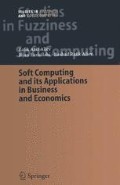Abstract
One of the first explicit uses of neural networks for time series analysis was in 1987 when Lapedes and Farber demonstrated that feed-forward neural networks could be used for modeling deterministic chaos [15].
Access this chapter
Tax calculation will be finalised at checkout
Purchases are for personal use only
Preview
Unable to display preview. Download preview PDF.
References
Aliev RA, Aliev RR (2001) Soft Computing and its Application. World Scientific, New Jersey, London, Singapure, Hong Kong
Aliev RA, Shachnazarov MM, Gulko DE (1988) Scheduling expert systems (in English and Russian). J News of Academy of Sciences of USSR, Tech. Cybernetics 5: 118–128
Aliev RA, Shakhnazarov MM, Abdikeev NM (1990) Intelligent control systems. Moscow: Radio I Svyaz (in Russian)
Bojadziev G, Bojadziev M (1997) Fuzzy logic for business, finance, and management. World Scientific
Buckley JJ, Hayashi Y (1998) Application of fuzzy chaos to fuzzy simulation. J Fuzzy Sets and Systems ‘89: 151–157
Chen SM (1996) Forecasting enrollments based on fuzzy time series. J Fuzzy Sets and Systems 81: 311–319
Chao-Chih Tsai, Shun-Jyh Wu (2000) Forecasting enrollments with high-order fuzzy time series. In: IEEE 19“ International Conference of the North American Fuzzy Information Processing Society, pp 196–200
Deboeck G (ed) (1994) Trading on the Edge. NY: John Wiley and Sons
Fazlollahi B, Aliev R (1998) Multi-agent systems in finance. In: Third Inter. Conf. on Application of Fuzzy Systems and Soft Computing. Wiesbaden, Germany, pp 65–62
Fazlollahi B, Aliev RR (2000) Forecasting time series system with fuzzy decision maker. In: World Conference on Intelligent Systems for Industrial Automation WCIS’2000. Tashkent, Uzbekistan, pp 111–114
Hwang JR, Chen S.M, Lee CH (1996) A new method for handling forecasting problems based on fuzzy time series. In: 7`in Internat. Conf. On Information Management. Chungli, Taoyuan, Taiwan, ROC, pp 312–321
Hwang JR, Chen ShM, Lee ChH (1998) Handling forecasting problems using fuzzy time series. J Fuzzy Sets and Systems 100: 217–228
Ishikawa A, Amagasa M, Shiga T, Tomizawa G, Tatsuta R, Mieno H (1993) The max-min Delphi method and fuzzy Delphi method via fuzzy integration. J Fuzzy Sets and Systems 55: 241–253
Jang JR, Sun C (1993) Predicting chaotic time series with fuzzy IF-THEN rules. In: Second IEEE Inter. Cons. Fuzzy systems. San Francisco, CA, Mar., vol 2, pp 1079–1084
Jason Kingdon (1998) Intelligent Systems and Financial Forecasting. Springer
Jeng-Ren Hwang, Shyi-Ming Chen, Chia-Hoang Lee (1998) Handling forecasting problems using fuzzy time series. J Fuzzy Sets and Systems 100: 217–228
Kaufmann A, Gupta (1988) MM Fuzzy Mathematical Models in Engineering and Management Science. North-Holland, Amsterdam
Kim D, Kim Ch (1997) Forecasting Time Series with Genetic Fuzzy Predictor Ensemble. J IEEE Transaction on Fuzzy Systems vol 5 (4): 523–535
Kuo RJ (1998) A decision support system for the stock market through integration of fuzzy neural networks and fuzzy Delphi. J Applied Artificial Intelligence 12: 501–520
Li Zuoyoung, Chen Zhenpei, Li Jitao (1988) A model of weather forecast by fuzzy grade statistics. J Fuzzy Sets and Systems 26: 275–281
Mohamad H Hassoun (1995) Fundamentals of Artificial Neural Networks. A Bradford Book
Murray TJ, Pipino LL, JP van Gigch, (1985) A pilot study of fuzzy set modification of Delphi. J Human Systems Mgmt. 5: 76–80
Oscar Castillo, Patricia Melin (2001) A New-Fractal Approach for Forecasting Financial and Economic Time Series. J IEEE: 929–934
Petridis V, Kehagias A (1997) Predictive modular fuzzy systems for time-series classification. J IEEE Transactions on Fuzzy Systems vol 5 (3): 381–397
Ping-Teng Chang, Liang-Chih Huang, Horng-Jiun Lin (2000) The fuzzy Delphi method via fuzzy statistics and membership function fitting and an application to the human resources. J Fuzzy Sets and Systems 112: 511–520
Richard B, Chace Nicholas, Aquuilano J, F Robert Jacobs (1998) Production and Operations Management. Manufacturing and Services. Irwin/McGrow-Hill
Song Q, Chissom BS (1993) Forecasting enrollments with fuzzy time series — part I. J Fuzzy Sets and Systems 54: 1–9
Song Q, Chissom BS (1994) Forecasting enrollments with fuzzy time series–part II. J Fuzzy Sets and Systems 62: 1–8
Song Q, Chissom BS (1993) Fuzzy time series and its models. J Fuzzy Sets and Systems 54: 269–277
Sullivan J, Woodall WI-I (1994) A comparison of fuzzy forecasting and Markov modeling. J Fuzzy Sets and Systems 64: 279–293
Tsai CC, Wu SJ (1999) A Study for Second-order Modeling of Fuzzy Time Series. In: IEEE International Fuzzy Systems Conference. Seoul, Korea
Zadeh L (1975) The concept of a linguistic variable and its application to approximate reasoning. J Information Sciences 8: 43–80
Author information
Authors and Affiliations
Rights and permissions
Copyright information
© 2004 Springer-Verlag Berlin Heidelberg
About this chapter
Cite this chapter
Aliev, R.A., Fazlollahi, B., Aliev, R.R. (2004). Soft Computing Technologies in Business and Economic Forecasting. In: Soft Computing and its Applications in Business and Economics. Studies in Fuzziness and Soft Computing, vol 157. Springer, Berlin, Heidelberg. https://doi.org/10.1007/978-3-540-44429-9_4
Download citation
DOI: https://doi.org/10.1007/978-3-540-44429-9_4
Publisher Name: Springer, Berlin, Heidelberg
Print ISBN: 978-3-642-53588-8
Online ISBN: 978-3-540-44429-9
eBook Packages: Springer Book Archive

